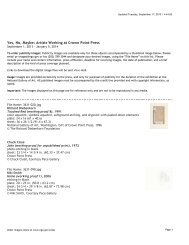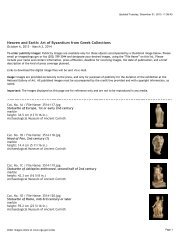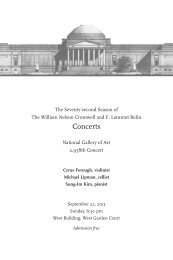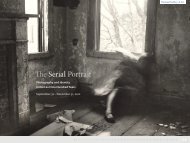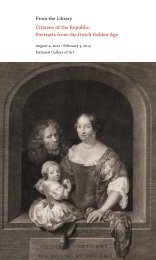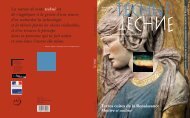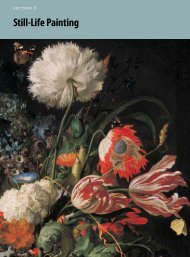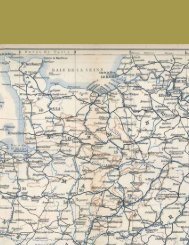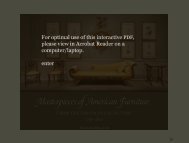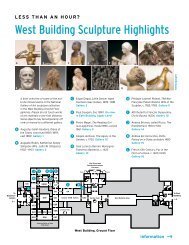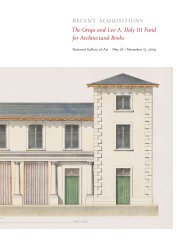Download Report - National Gallery of Art
Download Report - National Gallery of Art
Download Report - National Gallery of Art
Create successful ePaper yourself
Turn your PDF publications into a flip-book with our unique Google optimized e-Paper software.
Alexandre-François Desportes’ Still Life with Dressed<br />
Game, Meat, and Fruit, 1734, was acquired through the<br />
Chester Dale Fund. The eighteenth-century still life constitutes<br />
a striking example <strong>of</strong> the “buffet” picture, combining<br />
exquisite examples <strong>of</strong> cutlery, kitchenware, and silver service<br />
with an abundance <strong>of</strong> food implying the setting <strong>of</strong> a noble<br />
household. Desportes turns unusual attention to aspects<br />
such as the individual encasings <strong>of</strong> sculpted lard enveloping<br />
each dressed fowl and the bare, pimpled skin, webbed feet,<br />
and curving claws <strong>of</strong> the pheasants. The artist transforms<br />
the rack <strong>of</strong> lamb and entrails hanging on hooks to dry into<br />
an interplay between the translucence <strong>of</strong> flesh and solidity<br />
<strong>of</strong> white bone. The bulbous pears at the front <strong>of</strong> the picture,<br />
which seem to firmly situate the image within a Northern<br />
aesthetic, and the luminous oranges in the background<br />
complete the ensemble. The artist’s careful delineation <strong>of</strong><br />
contrasting (potentially distasteful) subject matter forces<br />
the spectator to acknowledge the sheer artistic prowess with<br />
which this virtuoso negotiates the relationship between<br />
beautiful and bizarre.<br />
Desportes’ career immediately precedes that <strong>of</strong> Jean<br />
Siméon Chardin, whose still-life paintings and genre scenes<br />
are great strengths <strong>of</strong> the <strong>Gallery</strong>’s collection. Desportes’<br />
still-life painting also complements the <strong>Gallery</strong>’s portrait<br />
<strong>of</strong> the Chevalier de Behringen by Jean-Baptiste Oudry.<br />
In addition to displaying these painters’ skill in rendering<br />
texture and color, these works also announce their nobility<br />
in referring to the traditional leisure pursuit <strong>of</strong> the landed<br />
gentry, the hunt.<br />
Hendrik Willem Mesdag’s Sunset at Scheveningen: A<br />
Fleet <strong>of</strong> Fishing Vessels at Anchor, 1894, is a spectacular<br />
example <strong>of</strong> the artist’s oeuvre, acquired through support <strong>of</strong><br />
funds given by Paul Mellon and Frank Anderson Trapp.<br />
Influenced by the dramatic marine paintings <strong>of</strong> Gustave<br />
Courbet in particular, Mesdag devoted most <strong>of</strong> his career<br />
to depicting the sea, which brought him recognition and<br />
provided an inexhaustible source <strong>of</strong> inspiration. The painting<br />
<strong>of</strong> a fleet <strong>of</strong> thirteen bomschuiten, or flat-bottomed fishing<br />
boats, is unlined, with Mesdag’s expressive brushwork<br />
and rich, atmospheric colors perfectly preserved. The artist<br />
most likely worked from sketches made outdoors to create<br />
this luminous painting, as he did for many <strong>of</strong> his other<br />
works in oil and watercolor.<br />
Known as the painter <strong>of</strong> the North Sea, Mesdag<br />
serves as a significant link between the Hague School<br />
and the French landscape painters <strong>of</strong> the nineteenth<br />
century. Building on the achievements in landscape<br />
painting <strong>of</strong> Dutch seventeenth-century masters, Hague<br />
School painters were inspired by the Barbizon school in<br />
France, a movement that reoriented the focus <strong>of</strong> landscape<br />
painting away from the Roman campagna to the<br />
richness and variety <strong>of</strong> their native land. Mesdag was<br />
himself a major collector <strong>of</strong> French Barbizon paintings,<br />
building one <strong>of</strong> the great private collections <strong>of</strong> work by<br />
NATIONAL GALLERY OF ART<br />
13<br />
Théodore Rousseau, Charles-François Daubigny, and<br />
Camille Corot. Sunset at Scheveningen joins Jacob Maris’<br />
View <strong>of</strong> the Mill and Bridge on the Noordwest Buitensingel<br />
in The Hague, 1873, as a second major Hague School<br />
painting, helping to expand the <strong>Gallery</strong>’s nineteenthcentury<br />
collection beyond its French confines.<br />
Two large panel paintings by the father <strong>of</strong> art history,<br />
Giorgio Vasari, were given to the <strong>Gallery</strong> by New York<br />
collector Damon Mezzacappa. Saint Mark and Saint Luke<br />
are the first paintings by Vasari to enter the collection,<br />
joining a page from his Libro de’ Disegni and first editions<br />
<strong>of</strong> the Lives. Part <strong>of</strong> a dismantled chapel complex for the<br />
Vatican that was commissioned by Pope Pius V in 1570,<br />
the panels will receive conservation treatment and new<br />
frames before they go on view.<br />
This year brought several important acquisitions in the<br />
area <strong>of</strong> modern art. At its annual meeting, the Collectors<br />
Committee acquired Étude, 1969, an oil painting by<br />
French-Hungarian artist Simon Hantaï made with his<br />
signature method <strong>of</strong> pliage (folding) that adds great<br />
strength to the <strong>Gallery</strong>’s nascent collection <strong>of</strong> postwar<br />
European art.<br />
Other significant acquisitions include William Bailey’s<br />
painting Piano Scuro, 2003, purchased through the<br />
Charina Endowment Fund; Constellation, Milky Way,<br />
1970, a double-tondo work by Leon Polk Smith, given by<br />
the artist’s foundation; and Coherence, 1966, by Paul Reed,<br />
the gift <strong>of</strong> Bill McGillicuddy.<br />
Simon Hantaï, Étude, Gift <strong>of</strong> the Collectors Committee




